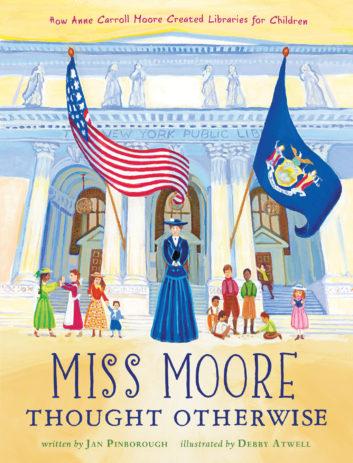J is for Juvenile
Juvenile seems like an outdated term but libraries still catalog books for children as Juvenile fiction or Juvenile nonfiction.

Did you know that children were not always welcomed in libraries? Early libraries were not free and open to the public. Usually they consisted of books collected by wealthy individuals who allowed people to purchase memberships for the privilege of reading the books. These collections did not have books for children.
This changed in the in the 1880’s when a few libraries began to develop “children’s rooms” for juvenile readers with books specifically written for them. One of the first was the Brookline Public Library in Massachusetts which opened in 1890 to keep noisy children out of the rest of the library.
You can read about one of the trailblazers of the children’s library movement in Miss Moore Thought Otherwise – How Anne Carroll Moore Created Libraries for Children by Jan Pinborough (author) and Debby Atwell (illustrator) Houghton Mifflin Books:2013

Anne Caroll Moore, who was born in 1871, “had large grey eyes, seven older brothers, and ideas of her own.” She dreamed of the world beyond and loved reading but wasn’t allowed to go inside of libraries. She wanted to become a lawyer like her father but when both he and her mother died of the flu so Anne was needed at home.
Eventually she learned that libraries were hiring women as librarians so she went to New York and enrolled in the Pratt Institute library school. She studied hard, graduated, and got her first job at the Pratt Free Library. This library had a room planned just for children. She did such an excellent job that she was asked to oversee children’s rooms in all thirty-six branches of the New York Public Library. She saw that many librarians didn’t want children to touch books because they thought children would ruin them. But Miss Moore knew better. She had children sign a pledge to care for the books. She worked hard to develop collections that children would enjoy.

She wrote book reviews and made lists of suggested books for young readers. She encouraged publishers to publish more quality books for children. When the massive New York Public Library was to be built, Miss Moore designed the children’s room. She made sure that it was a warm and inviting place. She invited musicians, storytellers, and famous authors to come to the library. She also made sure that the best librarians worked in the children’s rooms regardless of ethnicity.

Across America, libraries built children’s rooms based on Miss Moore’s ideas. Soon libraries around the world did, too. Today’s children’s rooms and children’s librarians continue to be influenced by the work of Anne Carroll Moore.
Did you spend part of your childhood in the juvenile section of your local library?
It seems like I spent most of my childhood in the children’s section of our local library. I can’t imagine a time when children weren’t welcome.
Hi Ellen, I think the children’s section is the best place to be in the library (that’s why I became a children’s librarian)
Hi Claire – what a fascinating post … I knew nothing of this … I now wonder how our libraries developed here in the UK. Love the book and the approach to telling the story – brilliant … and thanks so much for telling us about this – sensible woman … cheers Hilary
http://positiveletters.blogspot.co.uk/2017/04/j-is-for-jellicles.html
Hi Hilary, I know there are some beautiful libraries in the UK. I have visited a number of the university libraries. It would be interesting to see how they started.
This was an interesting read! I had no idea before that libraries weren’t always open to the public and didn’t allow children (though it makes sense that only the wealthy would be there since they were more likely to be literate back in those times).
I remember spending time in the children’s section of my old library (now my workplace, so weird and cool!). Of course, we just had the library renovated so it’s nothing like it was before.
How wonderful to work in your childhood library! I was a children’s librarian for years before I had kids and became a teacher so that I can be on their schedule.
Fascinating story!
When I was a child, we didn’t have a children room in the local library, just some “children shelves”. But yes, I spent hours there, and I think I read, if not all, 90% of children books there! Now the library has a wonderful children coin.